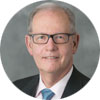Download PDF

In last month’s column, I highlighted three major drivers of change in our profession’s recent past and in its future: subspecialization, payment trends and reform, and consolidation in care delivery. As I noted, some of these are interrelated, and I will avoid commenting on science and technology. I will readily admit, however, that little could change the practice of ophthalmology more than a drop to reverse cataracts or effective, affordable gene therapy for common and severe ocular diseases.
Demographics. Last month I wrote about the subspecialization trend—about changes in what ophthalmologists do. Let’s focus now on the ophthalmologists themselves. Ten years ago, barely 20% of practicing ophthalmologists were women. Now, this number exceeds 25%. In last year’s residency match, 35% of applicants were women, and 39% of those who matched were women. Thirty years ago, common applicant surnames were Smith, George, and Brown. This year among the top five were Chen, Lee, and Patel. We are increasingly reflecting much of the heterogeneity of the American population itself with regard to some important measures of gender and cultural background. It’s a natural and healthy professional evolution. And in a few areas where the pace of change lags demographics, we have programs such as the Minority Ophthalmology Mentoring initiative.
Patient partnership in disease management. Early in my career, I remember a patient interrupting a surgical consent, “Doc, I don’t need to hear this. You’ll do what’s best, and if it works, that’s great. If it doesn’t, that was meant to be.” I remember (naively) thinking, “That’s so cool that he trusts me, and I don’t have to go through this consent.” Now, the typical patient has consulted extensively with Dr. Google and has an iPad loaded with questions. Historically, postsurgical patients with a red eye were nearly always met in the emergency room. AMD patients with questionable vision change were seen that week in the office. Now, red eyes may often be evaluated via a jpeg before an in-person visit is offered. AMD vision change may be evaluated by any one of various technologies including remote vision assessment, remote fundus imaging, or (soon) by home-based OCT. Increasingly, patients are active partners in selecting and monitoring their care.
Benchmark data and quality of care—a virtuous circle. No future physician ever went into medical school thinking “I want to be average.” We are all to one degree or another Type A professionals. We pursue continuing education to better provide our patients with high-quality care. But throughout most of my practice, when patients asked me, “When you do retinal detachment surgery, how well do your patients do?” I really couldn’t tell them. I didn’t have all the data, and I wasn’t sure if I was even measuring the right thing.
Now thanks to EHR analytics and clinical data registries like IRIS, we do have more data. And they are getting more robust each year. We are increasingly able to focus our professional development to our practice needs and deficiencies, measure our processes and outcomes of care, benchmark them to norms, and then adjust our education (and our outcomes). Rinse and repeat! Increasingly, our contracting and our payment will be partially based on outcomes. We and our patients both stand to win.
Black swan events. COVID-19 has taught us something that every economist knows. Specific rare events happen rarely, but “rare events” occur much more commonly—be they pandemics, seismic events, climate disasters, economic meltdowns, global conflicts, or cyberterrorism. They will define our future as they have defined our recent past. We have learned that, though such events may be individually unpredictable, we can prepare generically (and operate the Academy) by architecting and using systems that are flexible, resilient, and redundant.
Both our individual success and our future as a profession depend not only on day-to-day execution of our responsibilities—but also on our success in identifying and shaping our response to macrotrends and developing resiliency to meet the unanticipated challenges we are sure to encounter.